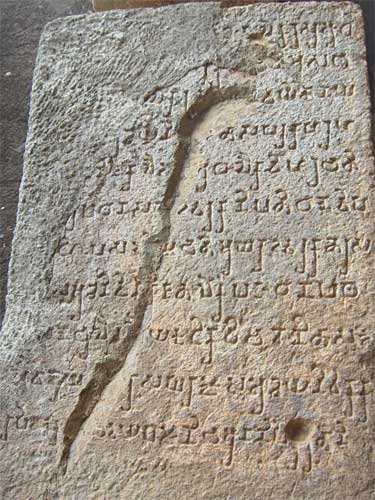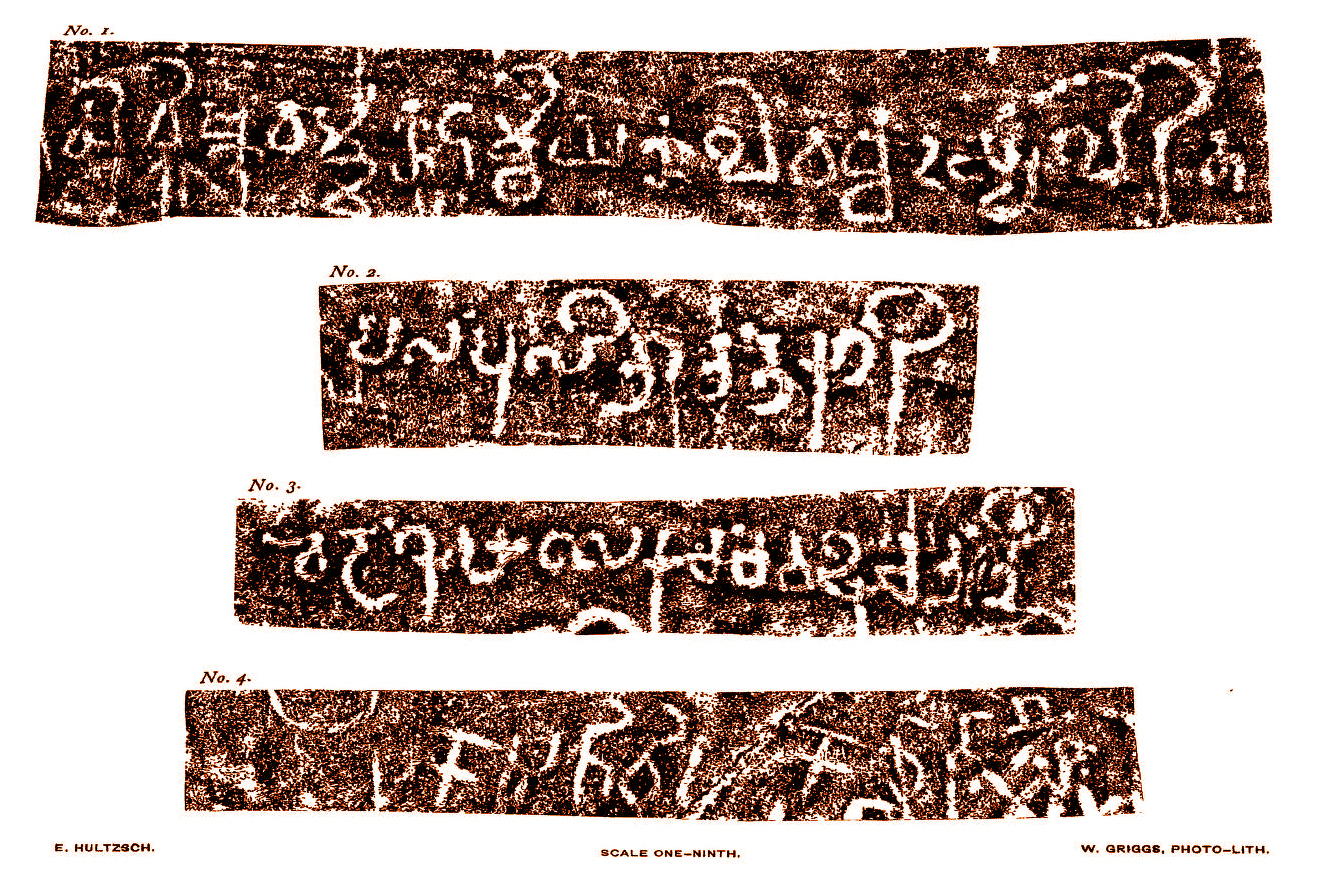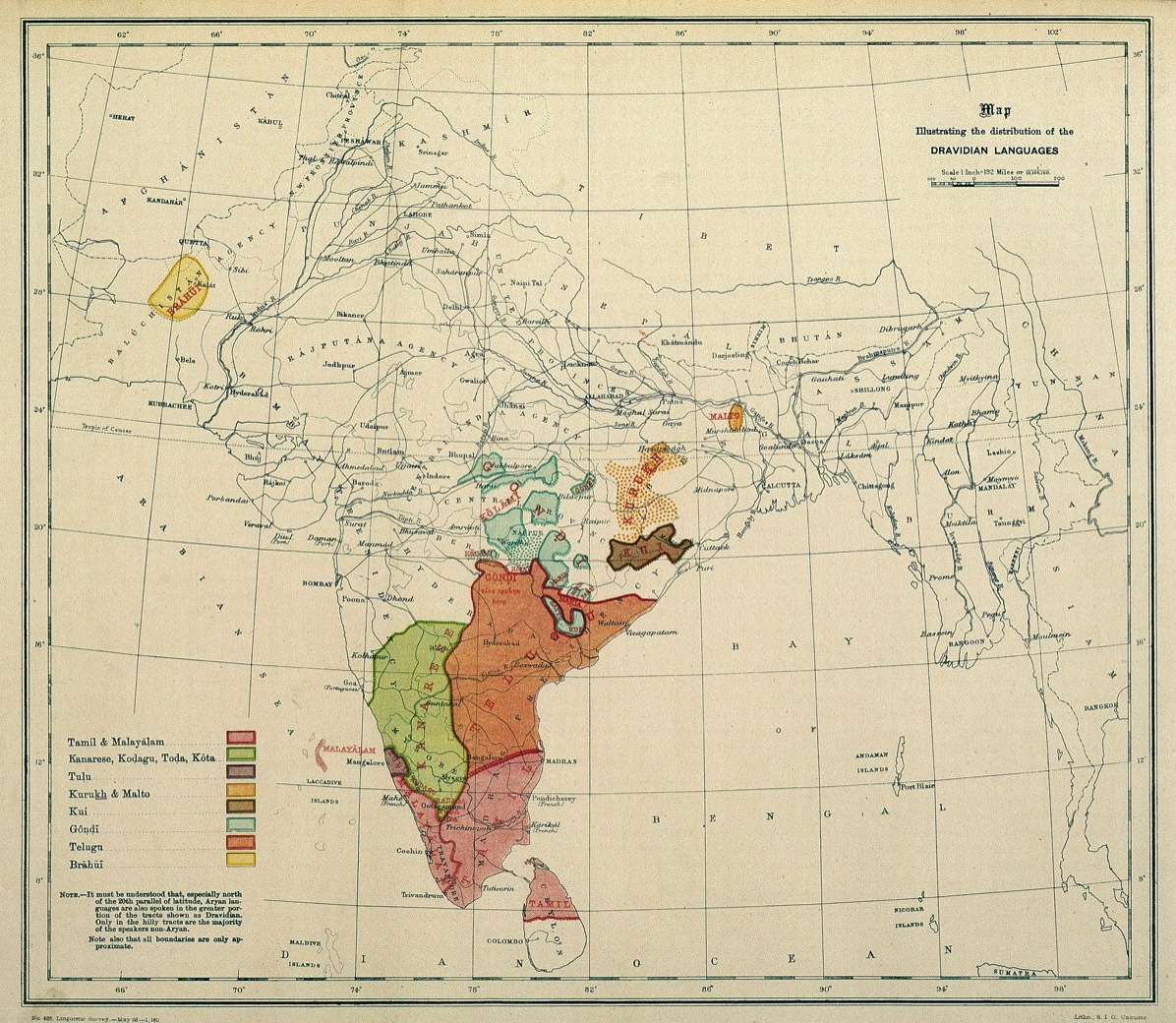|
Kannada Script
The Kannada script (IAST: ''Kannaḍa lipi''; obsolete: Kanarese or Canarese script in English) is an abugida of the Brahmic family, used to write Kannada, one of the Dravidian languages of South India especially in the state of Karnataka. Kannada script is also widely used for writing Sanskrit texts in Karnataka. Several minor languages, such as Tulu, Konkani, Kodava, Sanketi and Beary, also use alphabets based on the Kannada script. The Kannada and Telugu scripts share very high mutual intellegibility with each other, and are often considered to be regional variants of single script. Other scripts similar to Kannada script are Sinhala script (which included some elements from the Kadamba script), and Old Peguan script (used in Burma). The Kannada script ( ''akṣaramāle'' or ''varṇamāle'') is a phonemic abugida of forty-nine letters. The character set is almost identical to that of other Brahmic scripts. Consonantal letters imply an inherent vowel. Letters represe ... [...More Info...] [...Related Items...] OR: [Wikipedia] [Google] [Baidu] |
Abugida
An abugida (, from Ge'ez language, Ge'ez: ), sometimes known as alphasyllabary, neosyllabary or pseudo-alphabet, is a segmental Writing systems#Segmental writing system, writing system in which consonant-vowel sequences are written as units; each unit is based on a consonant letter, and vowel notation is secondary. This contrasts with a full alphabet, in which vowels have status equal to consonants, and with an abjad, in which vowel marking is absent, Abjad#Impure abjads, partial, or optional (although in less formal contexts, all three types of script may be termed alphabets). The terms also contrast them with a syllabary, in which the symbols cannot be split into separate consonants and vowels. Related concepts were introduced independently in 1948 by James Germain Février (using the term ) and David Diringer (using the term ''semisyllabary''), then in 1959 by Fred Householder (introducing the term ''pseudo-alphabet''). The Ethiopian Semitic languages, Ethiopic term "abugi ... [...More Info...] [...Related Items...] OR: [Wikipedia] [Google] [Baidu] |
Goykanadi
or Kandavī is a Brahmic script that was once used in the territory of Goa to write Konkani and sometimes Marathi in the Konkan coast. Similarly, it was used by the trading Saraswat and Daivajna families along with the Modi script to maintain their accounts. Overview Goykanadi was used in Goa since the times of the Kadambas, although it lost its popularity after the 17th century. Goykanadi is very different from the Old Kannada script, with strikingly similar features. Unlike Old Kannada, Kandevi/Goykanadi letters were usually written with a distinctive horizontal bar, like the Nagari scripts. This script may have been evolved out of the Kadamba script, which was extensively used in Goa and Konkan. Usage and extinction The inquisition of Goa is seen as a blot in the history of the Konkani language. According to the orders of the Goa inquisition it was an offence to remain in possession of books in the local languages. All books, whatever their subject matter, written in ... [...More Info...] [...Related Items...] OR: [Wikipedia] [Google] [Baidu] |
Peguan Language
The Mon language (, mnw, ဘာသာမန်, links=no, (Mon-Thai ဘာသာမည်) ; my, မွန်ဘာသာ; th, ภาษามอญ; formerly known as Peguan and Talaing) is an Austroasiatic language spoken by the Mon people. Mon, like the related Khmer language, but unlike most languages in mainland Southeast Asia, is not tonal. The Mon language is a recognised indigenous language in Myanmar as well as a recognised indigenous language of Thailand. Mon was classified as a "vulnerable" language in UNESCO's 2010 ''Atlas of the World’s Languages in Danger''. The Mon language has faced assimilative pressures in both Myanmar and Thailand, where many individuals of Mon descent are now monolingual in Burmese or Thai respectively. In 2007, Mon speakers were estimated to number between 800,000 and 1 million. In Myanmar, the majority of Mon speakers live in Southern Myanmar, especially Mon State, followed by Tanintharyi Region and Kayin State. History Mon is an im ... [...More Info...] [...Related Items...] OR: [Wikipedia] [Google] [Baidu] |
Kadamba Script
The Kadamba script is the first writing system devised specifically for writing Kannada and Telugu. It is a descendant of the Brahmi script. The Kadamba script is also known as ''Pre-Old-Kannada script''. The Kadamba script is one of the oldest of the southern group of Brahmic scripts that evolved from the Brahmi script. By the 5th century CE it became distinct from other Brahmi variants and was used in southern Indian states of Karnataka and Andhra Pradesh. It evolved into the Old Kannada script by the 10th century CE and was used to write Kannada and Telugu. It is also related to the Sinhala script. History During the rule of Kadamba dynasty (325-550), major change in the Brahmi script resulted in the Kadamba Kannada script, letters were shorter and round in shape. During (325 to 1000 AD) the rule of the Western Ganga dynasty in the southern parts of Karnataka the Kannada script used differently (also known as Ganga script) in rock edicts and copper plate inscriptions. Du ... [...More Info...] [...Related Items...] OR: [Wikipedia] [Google] [Baidu] |
Sinhala Script
The Sinhala script ( si, සිංහල අක්ෂර මාලාව, Siṁhala Akṣara Mālāva), also known as Sinhalese script, is a writing system used by the Sinhalese people and most Sri Lankans in Sri Lanka and elsewhere to write the Sinhala language as well as the liturgical languages Pali and Sanskrit.Daniels (1996), p. 408. The Sinhalese Akṣara Mālāva, one of the Brahmic scripts, is a descendant of the Ancient Indian Brahmi script. It is also related to the Grantha script. The Sinhala script is an abugida written from left to right. Sinhala letters are classified in two sets. The core set of letters forms the ' alphabet (Pure Sinhala, ), which is a subset of the ' alphabet (Mixed Sinhala, ). History The Sinhala script is a Brahmi derivate and was imported from Northern India around the 3rd century BCE. It developed in a complex manner, partly independently but also strongly influenced by South Indian scripts at various stages, manifestly influenced by the ... [...More Info...] [...Related Items...] OR: [Wikipedia] [Google] [Baidu] |
Karnataka
Karnataka (; ISO: , , also known as Karunāḍu) is a state in the southwestern region of India. It was formed on 1 November 1956, with the passage of the States Reorganisation Act. Originally known as Mysore State , it was renamed ''Karnataka'' in 1973. The state corresponds to the Carnatic region. Its capital and largest city is Bengaluru. Karnataka is bordered by the Lakshadweep Sea to the west, Goa to the northwest, Maharashtra to the north, Telangana to the northeast, Andhra Pradesh to the east, Tamil Nadu to the southeast, and Kerala to the southwest. It is the only southern state to have land borders with all of the other four southern Indian sister states. The state covers an area of , or 5.83 percent of the total geographical area of India. It is the sixth-largest Indian state by area. With 61,130,704 inhabitants at the 2011 census, Karnataka is the eighth-largest state by population, comprising 31 districts. Kannada, one of the classical languages of India, ... [...More Info...] [...Related Items...] OR: [Wikipedia] [Google] [Baidu] |
South India
South India, also known as Dakshina Bharata or Peninsular India, consists of the peninsular southern part of India. It encompasses the Indian states of Andhra Pradesh, Karnataka, Kerala, Tamil Nadu, and Telangana, as well as the union territories of Lakshadweep and Puducherry, comprising 19.31% of India's area () and 20% of India's population. Covering the southern part of the peninsular Deccan Plateau, South India is bounded by the Bay of Bengal in the east, the Arabian Sea in the west and the Indian Ocean in the south. The geography of the region is diverse with two mountain ranges – the Western and Eastern Ghats – bordering the plateau heartland. The Godavari, Krishna, Kaveri, Tungabhadra, Periyar, Bharathappuzha, Pamba, Thamirabarani, Palar, and Vaigai rivers are important perennial rivers. The majority of the people in South India speak at least one of the four major Dravidian languages: Tamil, Telugu, Malayalam and Kannada (all 4 of which are among the 6 Classic ... [...More Info...] [...Related Items...] OR: [Wikipedia] [Google] [Baidu] |
Dravidian Languages
The Dravidian languages (or sometimes Dravidic) are a family of languages spoken by 250 million people, mainly in southern India, north-east Sri Lanka, and south-west Pakistan. Since the colonial era, there have been small but significant immigrant communities in Mauritius, Myanmar, Singapore, Malaysia, Indonesia, Philippines, United Kingdom, Australia, France, Canada, Germany, South Africa, and the United States. The Dravidian languages are first attested in the 2nd century BCE, as Tamil-Brahmi script, inscribed on the cave walls in the Madurai and Tirunelveli districts of Tamil Nadu. The Dravidian languages with the most speakers are (in descending order of number of speakers) Telugu, Tamil, Kannada and Malayalam, all of which have long literary traditions. Smaller literary languages are Tulu and Kodava. There are also a number of Dravidian-speaking scheduled tribes, such as the Kurukh in Eastern India and Gondi in Central India. Outside of India, Brahui is mo ... [...More Info...] [...Related Items...] OR: [Wikipedia] [Google] [Baidu] |
New York (state)
New York, officially the State of New York, is a state in the Northeastern United States. It is often called New York State to distinguish it from its largest city, New York City. With a total area of , New York is the 27th-largest U.S. state by area. With 20.2 million people, it is the fourth-most-populous state in the United States as of 2021, with approximately 44% living in New York City, including 25% of the state's population within Brooklyn and Queens, and another 15% on the remainder of Long Island, the most populous island in the United States. The state is bordered by New Jersey and Pennsylvania to the south, and Connecticut, Massachusetts, and Vermont to the east; it has a maritime border with Rhode Island, east of Long Island, as well as an international border with the Canadian provinces of Quebec to the north and Ontario to the northwest. New York City (NYC) is the most populous city in the United States, and around two-thirds of the state's popul ... [...More Info...] [...Related Items...] OR: [Wikipedia] [Google] [Baidu] |
Routledge
Routledge () is a British multinational publisher. It was founded in 1836 by George Routledge, and specialises in providing academic books, journals and online resources in the fields of the humanities, behavioural science, education, law, and social science. The company publishes approximately 1,800 journals and 5,000 new books each year and their backlist encompasses over 70,000 titles. Routledge is claimed to be the largest global academic publisher within humanities and social sciences. In 1998, Routledge became a subdivision and imprint of its former rival, Taylor & Francis Group (T&F), as a result of a £90-million acquisition deal from Cinven, a venture capital group which had purchased it two years previously for £25 million. Following the merger of Informa and T&F in 2004, Routledge became a publishing unit and major imprint within the Informa "academic publishing" division. Routledge is headquartered in the main T&F office in Milton Park, Abingdon, Oxfordshire and ... [...More Info...] [...Related Items...] OR: [Wikipedia] [Google] [Baidu] |
Brahmic Scripts
The Brahmic scripts, also known as Indic scripts, are a family of abugida writing systems. They are used throughout the Indian subcontinent, Southeast Asia and parts of East Asia. They are descended from the Brahmi script of ancient India and are used by various languages in several language families in South, East and Southeast Asia: Indo-Aryan, Dravidian, Tibeto-Burman, Mongolic, Austroasiatic, Austronesian, and Tai. They were also the source of the dictionary order (''gojūon'') of Japanese ''kana''. History Brahmic scripts descended from the Brahmi script. Brahmi is clearly attested from the 3rd century BCE during the reign of Ashoka, who used the script for imperial edicts, but there are some claims of earlier epigraphy found on pottery in southern India and Sri Lanka. The most reliable of these were short Brahmi inscriptions dated to the 4th century BCE and published by Coningham et al. (1996). Northern Brahmi gave rise to the Gupta script during the Gupt ... [...More Info...] [...Related Items...] OR: [Wikipedia] [Google] [Baidu] |
Abugida
An abugida (, from Ge'ez language, Ge'ez: ), sometimes known as alphasyllabary, neosyllabary or pseudo-alphabet, is a segmental Writing systems#Segmental writing system, writing system in which consonant-vowel sequences are written as units; each unit is based on a consonant letter, and vowel notation is secondary. This contrasts with a full alphabet, in which vowels have status equal to consonants, and with an abjad, in which vowel marking is absent, Abjad#Impure abjads, partial, or optional (although in less formal contexts, all three types of script may be termed alphabets). The terms also contrast them with a syllabary, in which the symbols cannot be split into separate consonants and vowels. Related concepts were introduced independently in 1948 by James Germain Février (using the term ) and David Diringer (using the term ''semisyllabary''), then in 1959 by Fred Householder (introducing the term ''pseudo-alphabet''). The Ethiopian Semitic languages, Ethiopic term "abugi ... [...More Info...] [...Related Items...] OR: [Wikipedia] [Google] [Baidu] |




